Several companies manufacture “copper” coated cookware. Some of these coatings are actually copper infused and others are only copper colored. It’s important to know which is which so that you can make an informed purchase. Below are a few from these two categories.
Copper Chef
Copper Chef’s website provides no information about the safety of their nonstick coating, as far as toxic chemicals are concerned. They do not even address it in their FAQs. Nor do they say that there is actually any copper in their non stick coating.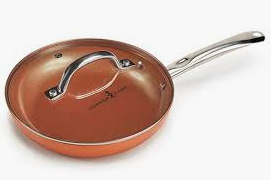 That leaves me to assume that their coating, which they call Cerami-Tech, is simply a copper-colored ceramic coating. They also make a line of cookware that is diamond-infused and they very clearly state that it is.
That leaves me to assume that their coating, which they call Cerami-Tech, is simply a copper-colored ceramic coating. They also make a line of cookware that is diamond-infused and they very clearly state that it is.
Since it is a ceramic coating, I would also assume that it is as safe as any other, but I personally feel more comfortable with a company that offers all relevant information and makes clear, direct statements about the safety of their product. Although Copper Chef is probably as safe as any other ceramic non stick cookware, I would feel a lot better knowing that they think being free of toxic chemicals is important enough to to include in the information they provide to the consumer.
Red Copper Pan
Red Copper Pan (as seen on TV) clearly states on their website that their non stick ceramic coating is copper-infused and also free of toxic chemicals. The copper does not come in contact with the food, therefore there is no danger of copper leaching into acidic foods unless the surface is damaged.
Like cast iron, the Red Copper Pan requires a simple periodic seasoning process. Red Copper cookware and bakeware is oven-safe up to 500°.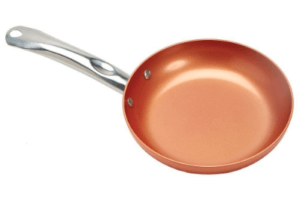 From all the reviews I’ve read, it is accurately represented by the advertising. It performs well, cleans up very easily, and will hold up well if not damaged by improper handling. Follow the manufacturer’s instructions and your Red Copper Pan should prove a good investment.
From all the reviews I’ve read, it is accurately represented by the advertising. It performs well, cleans up very easily, and will hold up well if not damaged by improper handling. Follow the manufacturer’s instructions and your Red Copper Pan should prove a good investment.
I have never used the Red Copper Pan myself, but I have a friend who has been using one for a few years and is happy with the performance. Her pan doesn’t look great at this point, having lots of burnt buildup on the inside surface, but I have had the opportunity to observe that she is not particularly careful about following all of the manufacturer’s instructions and I suspect that would account for the appearance.
Following the manufacturer’s instructions for use and care is essential to accurately judging the quality, durability, and performance of any cookware. Bear that in mind with any choice you make. How you care for it will make a big difference!
One thing I don’t like is that their cookware set includes an aluminum steamer basket. I will not cook or bake with exposed aluminum under any circumstances, but more about that in another post.
Michelangelo
This company refers to their cookware as “copper,” but in this case that seems to be a reference only to the color. They describe their nonstick coating as ceramic and titanium, and represent it as ultra-nonstick and scratch resistant. The coating is PTFA, PFOA, lead and cadmium free, and is oven safe up to 450˚. They also make the standard claims of easy clean-up, efficient cooking, and durability, and call it “dishwasher safe,” but still recommend hand washing.
They describe their nonstick coating as ceramic and titanium, and represent it as ultra-nonstick and scratch resistant. The coating is PTFA, PFOA, lead and cadmium free, and is oven safe up to 450˚. They also make the standard claims of easy clean-up, efficient cooking, and durability, and call it “dishwasher safe,” but still recommend hand washing.
Gotham Steel
Gotham Steel makes cookware with a copper colored ceramic coating called TIcerama, which is made with titanium. The cookware is designed by Chef Daniel Green. It’s free of toxic chemicals, it’s oven safe up to 500˚ F, and the handles are said to be “stay cool,” although I am sure that applies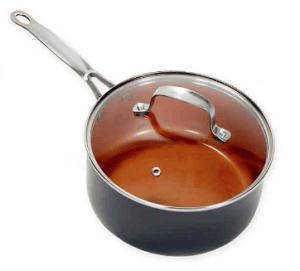 only when used on the stovetop and not in the oven!
only when used on the stovetop and not in the oven!
Gotham Steel claims that their TIcerama coating is scratch proof and metal utensil safe, as well as dishwasher safe. Still, I would always avoid using metal utensils with any nonstick cookware and would also opt to wash by hand. It just makes good sense to be as gentle as possible with your nonstick cookware in order to ensure its optimal longevity.
As with the Red Copper set (which is actually infused with copper), there is a steamer basket included in the Gotham Steel set. I haven’t seen it in person and I can’t find any information on it, but in the pictures it at least appears to be made of stainless steel, which is far preferable to Red Copper’s aluminum steamer basket.
More healthy nonstick cookware options to come in a future post. . . .
To your healthy kitchen
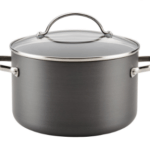 The oxidized layer makes it quite different from regular aluminum cookware. The surface is much harder and denser than non-anodized aluminum and nearly as strong as stainless steel. It is impact resistant, as well as corrosion and rust resistant. The surface is also non-porous and therefore non stick.
The oxidized layer makes it quite different from regular aluminum cookware. The surface is much harder and denser than non-anodized aluminum and nearly as strong as stainless steel. It is impact resistant, as well as corrosion and rust resistant. The surface is also non-porous and therefore non stick.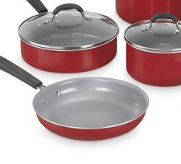 It is usually made of hard, anodized aluminum with a ceramic coating that is applied by either spraying or dipping and then “curing” in a high-heat firing process. Ceramic coated non stick cookware is easy to clean and it is supposedly heat resistant up to 842º F. Nevertheless, high heat is not recommended, as it will definitely shorten the life of the cookware.
It is usually made of hard, anodized aluminum with a ceramic coating that is applied by either spraying or dipping and then “curing” in a high-heat firing process. Ceramic coated non stick cookware is easy to clean and it is supposedly heat resistant up to 842º F. Nevertheless, high heat is not recommended, as it will definitely shorten the life of the cookware. The metal base of the cookware may be made of either cast iron, stainless steel, or aluminum. Each of these is durable, but cast iron is the heaviest and aluminum the most lightweight. Some of this cookware is also coated on the outside and comes in a rainbow of decorative colors.
The metal base of the cookware may be made of either cast iron, stainless steel, or aluminum. Each of these is durable, but cast iron is the heaviest and aluminum the most lightweight. Some of this cookware is also coated on the outside and comes in a rainbow of decorative colors.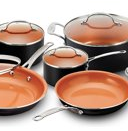 ceramic coatings and some are simply copper-colored ceramic coatings. Ceramic non stick coatings are 100% nontoxic. Copper has non stick properties and is the most efficient conductor of heat. The durability and life of the pan will depend on whether or not it is made by a reputable manufacturer and if you follow the instructions for use and care.
ceramic coatings and some are simply copper-colored ceramic coatings. Ceramic non stick coatings are 100% nontoxic. Copper has non stick properties and is the most efficient conductor of heat. The durability and life of the pan will depend on whether or not it is made by a reputable manufacturer and if you follow the instructions for use and care.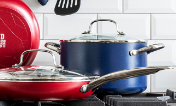 If manufacturer’s instructions are faithfully followed, this non stick coating will neither chip nor crack, and can even stand up to metal utensils (although I would still opt not to use metal).
If manufacturer’s instructions are faithfully followed, this non stick coating will neither chip nor crack, and can even stand up to metal utensils (although I would still opt not to use metal).